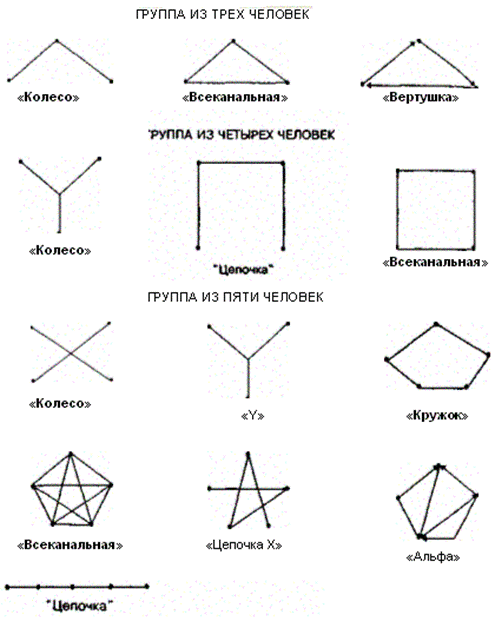home
 Management Management
 Management - Vikhansky OS Management - Vikhansky OS
|
Management - Vikhansky OS
1.3. Communication networks
Communication Network - the compound in a certain way involved in the communication process of individuals with the help of information flows (Figure 9.2.). In this case, the individuals are not considered as such, and communication relationships between individuals. The communication network includes a flow of messages or signals between two or more individuals. The communication network is focused on the organization developed in the samples of these flows and not on whether it was possible to transfer the value or meaning of the message. However, the communication network can be affected by a reduction or increase in the gap between the value of the sent and received.

Fig. 9.2. Interpersonal communication network group leader in the organization
Created by the head of the network consists of vertical, horizontal and diagonal braces. Vertical communications are based on the guide line from the head to subordinates. Horizontal communications are carried out between the same levels of individuals or parts of the organization: among the deputies, by the heads of departments, between subordinates. Diagonal ties - is communication with other supervisors and other subordinates. The network of these relationships creates the actual structure of the organization. The task of the formal organizational structure is to make the communication flows in the right direction. Dimensions divisions in the organization to limit the possibility of the development of the communication network. If the group size is increased in an arithmetic progression, the number of possible communication relations is increasing exponentially. Hence the communications network in a group of 12 people from more diverse and complex than in a three-man group. Depending on how the built communication networks, activities of the group can vary to a greater or lesser efficiency.
There are well-established communication network samples for groups of the same or different size (Fig. 9.3). In networks such as "circle" team members can communicate only with those who are located next to them. In networks "wheel" type presented a formal, centralized hierarchy of power, in which the slave communicates with each other through their boss. The objective basis for this situation is that the person who is b "wheels" center, has more communication links than the other band members. He receives more messages more often recognized by other members of the group as the person performing the functions of leadership, has a greater social impact on the other members of the group, usually carries a great responsibility for the transfer of information from it more than others, it is expected a final solution to the problem.

Fig. 9 3. Samples of communication networks in groups
A similar pattern is observed in type «Y» networks. Such networks are called centralized and can be effective if they solve simple problems. Another type of power hierarchy represent the network of the "chain", in which there are horizontal linkages - an element of decentralization. "All-channel" networks are fully decentralized group. Usually it is required that all should participate in solving complex problems. This approach is also called the open communications.
Knowledge of types of communication networks is especially important for understanding the relations of power and control in the organization. It is known that the concealment or centralization of information support power relations.
The character of the interdependence of people and work in a group or organization will determine the type of more effective communications network. Simple interdependence allows use of centralized networks. The complex interdependence requires a "team" approach to the construction of communication networks. However, a complex network can not solve a simple problem.


Comments
Commenting, keep in mind that the content and the tone of your messages can hurt the feelings of real people, show respect and tolerance to his interlocutors, even if you do not share their opinion, your behavior in terms of freedom of speech and anonymity offered by the Internet, is changing not only virtual, but real world. All comments are hidden from the index, spam control.